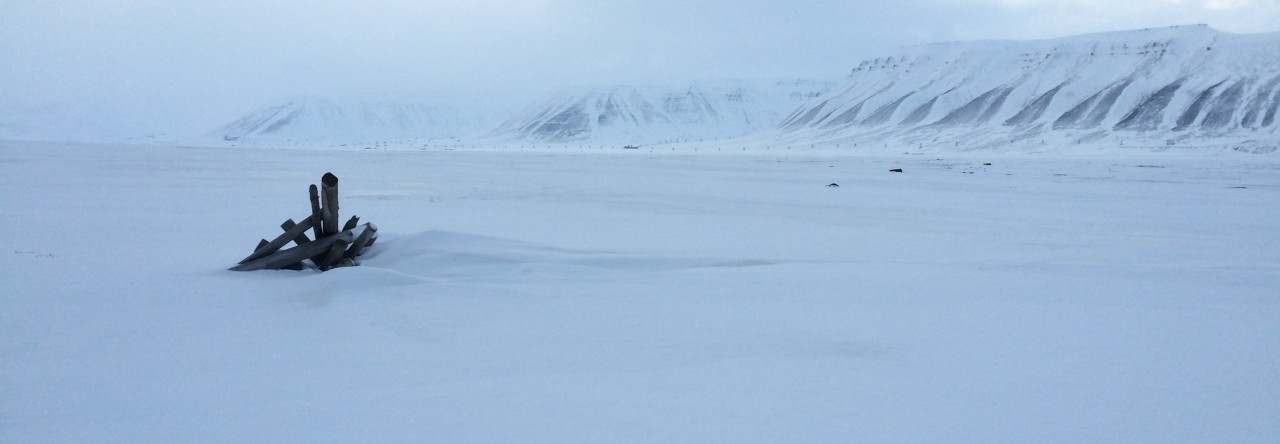I am in love with winter. Of course I have my limits—winter wears on us all. But I am in love with it, wild blizzard and what have you. I’d rather shiver than sweat. I’d rather ski than walk—though, as the Norwegian language would have it, the two, walking and skiing, are cut of the same stone. Unlike English, there’s no Norwegian verb “to ski.” In Norwegian, you “går på ski,” or “walk on skis” (unless you’re going downhill, in which case you “står på ski,” or “stand on skis”). Thus, in Norway, you walk all the year through—always a tur to gå, but sometimes you use shoes, sometimes skis, gå på sko or gå på ski, only a shift of medium. So I am in love with winter.
One of William Blake’s “Proverbs of Hell” says that “Eternity is in love with the productions of time”—and something about winter, especially winter up here where I write this, some sixty-eight degrees above the equator, towards the outermost islands in the Lofoten archipelago, brings the productions of time into stark relief. Here is a winter tightly knitted to sky and sea, and to the darkness in both. Everything is slower, and somehow sweeter. Cold honey. And with the Norwegian Sea pressing in, ancient and forbidding, on all sides, it’s not the deep-frozen, stock-stillness of Østlandet, shielded as it is by the mountain-spine of the norðrvegr. Lofoten in winter is (based on my scant few-days-worth of impressions) a place suspended between freeze and fluid. And fesk overalt (in the northern dialects, fish are fesk rather than the fisk so many Americans recognize in words like lutefisk). And today, the hard, hard life of the fisherfolk has been transubstantiated into tourism. Fish is still the fulcrum on which Lofoten’s culture turns, the heart of Norway’s traditional fishing identity—like what Seattle is, perhaps, to contemporary American coffee culture. Indeed, visually, if you were to pluck up Norway like a fish from the map, you’d likely grab it by the Lofotens, jutting out as though they were the country’s gills, breathing seaward. But the reality of that old life, persistent, has been transformed into images—compelling images, to be sure. But in a sort of quantum-physical way, realities that develop in isolation are altered fundamentally by outsiders’ observation. Ferries packed with visitors disembark & stay in picturesque villages. In a conversation last night with my host here in Leknes—add him to the list of generous Norwegian hosts—we spoke of the tourism that now buoys up this string of fishing villages that grow increasingly isolated as one moves vestover. Each waterside Lofoten hamlet is nestled always between the sea and the toothy spires that fly up out of it like titanic whales, frozen mid-breach. In each, tourists can find lodging in these rorbuer, little networks of cabins, suspended on stilts over the water along the shore. Rorbu, my host suggested, is best translated as “fishing shed,” as these were the historical sheds that the pre-industrial fisherfolk slept in between long, long days out to fesk. These sleeping hours were raw and low, only enough space to host some precious few hours of sleep between attempts to carve some sparse living out of the hard, hard sea. But the term, he noted, really comes from “rowing”—the fishers rowed out for the daily catch. No industrial fishing boats. Not even a fifteen-horse Evinrude to drive the hunt for the torsk—cod—hiding below the merciless chop of the surface. Imagine it. Just imagine. Rowing sheds, they were. Bare, brawny boat-houses. What night-thoughts inhabited those huts? What had they seen, those days out to sea, in rowboats, on the whale-road, looking for cod?
For almost a year and a half I’ve been waiting to visit Lofoten. I looked at images of one such idyllic fishing village called Reine. Surreal, it seemed (and I saw it, mostly, in summer, they way it’s most often presented in that other ocean, the Internet). As with Ísafjörður in Iceland, Reine seemed to beckon me from its place on the map. But Reine’s winterclothes I’ll take any day. Snow gives to rock something special. Something summer, with its ease—its gab, even—and its loitering, can’t offer. Something rarer. But for all its uniqueness, Reine lies further inward than its neighbor, Å. When I came to Norway and began practicing Norwegian as often as I could, I learned from friends of a special Norwegian sentence, which serves as this post’s title: Æ e i Å, æ og, which, in the northern Norwegian dialects, means “I, too, am in Å” (literally, “I am in Å, I too”). If you’d like to try to say it, the Æ is like the ‘a’ in ‘bad’; the e is like like the Canadian “eh”; the i is ‘ee’; and the Å is a little like the ‘oa’ sound in the name ‘Roald.’ Æ e i Å. I said that sentence in Å i Lofoten, I did. It was good. Standing in Å, outermost of the Lofoten settlements (though Værøy and Røst lie out further yet), felt a little like Skálavík in Iceland. And like Skálavík, I had to fight myself to leave. I could stand and stand and stare seaward, listening to the roar of the Norwegian sea. But I pulled myself away (the darkness helps discourage looking after a certain hour). I spent that evening, then, at the home of my host. We walked on skis (my second evening skitur in Lofoten) on lysløyper, and under nordlys, shimmering faintly, but perceptibly, behind the thin layer of wintercloud, and bluer for that barrier. Something else, altogether. Something else.
And how lucky to have this strange, strange opportunity. How unsettling, at the same time, the luxury of travel. How unequally accessible. I’m glad in the work, at least. I’m glad it’s the work I love that brings me here.



Leave a Reply